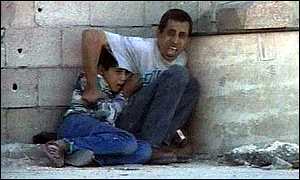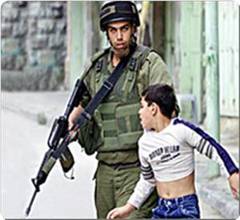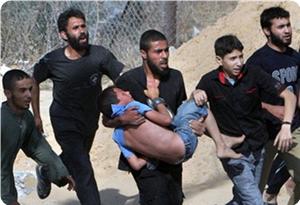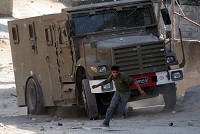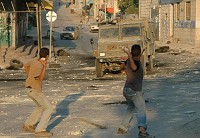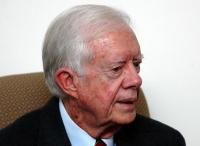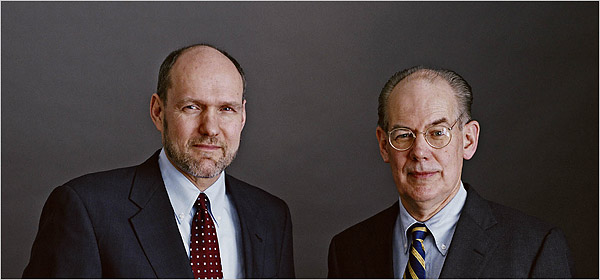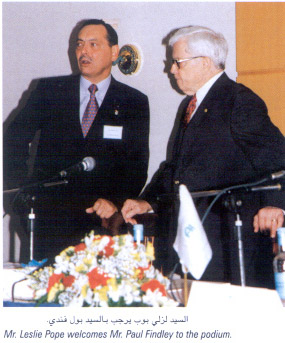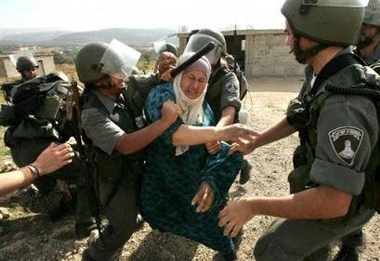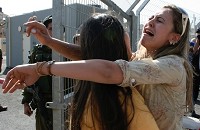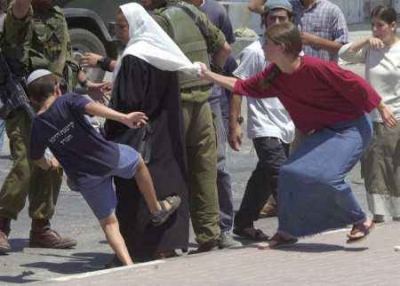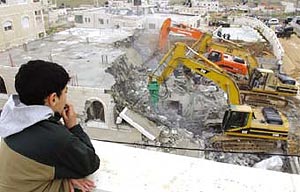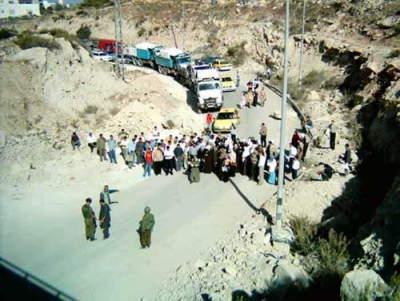|
Persecution of Palestinians
3. Labeling Palestinians as "Terrorists" Perpetuates Persecuting them by the Israeli Occupiers and their Supporters 1. Who is the real terrorist, the invading Israeli occupiers, or the invaded Palestinians under the most brutal and longest foreign occupation in recent history? a) History of the Zionist Invasion of the Middle East, Main Events
- 1897: The first World Zionist Conference headed by Hirzel, decides to usurp Palestine from its inhabitants and give it to Zionists. - 1917: British forces occupied Palestine. The infamous British foreign minister, Balfour, promised Zionist Rotschild British help to give Palestine to Zionists. This has become known as the Balfour Declaration. - 1947: The UN General Assembly passes Resolution 181 to partition Palestine, giving Zionists 56% of Palestine, though they only possessed about 5% of the lands, and despite the fact they were half a million while there were 1.3 million Palestinians. - 1948: Israel was declared by Zionists, who evicted Palestinians from their lands, the most infamous ethnic cleansing in the 20th century. This forced population transfer created the Palestinian refugee problem, which persists until today. Zionists also occupied and annexed more lands than the Partition Resolution gave them. In particular, they annexed the Galilee in the north, Aujah in the South, occupied West Jerusalem and the land corridor leading to it. This gave them 78% of Palestine instead of the 56% given to them by the Partition resolution. The annexation by force of 22% of Palestine made the Israeli government an occupying force since its inception. It has adopted and maintained the policy of acquisition of land and occupation ever since. - 1948: The UN General Assembly passed Resolution 194 calling for the repatriation and compensation of Palestinian refugees. Successive Israeli occupation governments never complied with this resolution, which blocked any resolution of the Palestinian refugee problem until today. b) Expanding the Conflict to Other Arab States, in Addition to the Palestinian People - 1956: The Israeli occupation government participated with the British and French imperialist governments in attacking Egypt, in what became known as the Suez Canal War. While the British and French imperialist forces occupied the Suez Canal area, the Israeli occupation government joined the imperialist camp by occupying the Egyptian territory of the Sinai Peninsula and the Palestinian territory of Gaza Strip. President Eisenhower ordered the three aggressors to withdraw from the Suez Canal, Sinai, and Gaza Strip. They did and that was the second time an American president dared to confront the Israel Lobby. The first was President Roosevelt, when he refused to pressure the British government to allow 300,000 European Jews to go to be repatriated in Palestine. He offered them to come to America instead. As soon as he died, his successor, President Truman, adopted the Zionist project as his own and asked the British to allow them entry to Palestine. - 1967: The Israeli occupation imperialist government launch war on three neighboring Arab states: Egypt, Jordan, and Syria, occupying Egyptian Sinai again, the Syrian Golan Heights, and the two Palestinian territories of the West Bank (which was under Jordanian rule) and Gaza Strip (which was under Egyptian administration). Zionists rejoiced worldwide thinking that a major stage of their dream of an Israeli Empire from the Nile to the Euphrates was achieved. The US entered the conflict forcefully, siding with the victor, providing the Israeli occupation imperialist government everything it needed to control the occupied Arab territories and the Palestinian people in the occupied territories of the West Bank and Gaza Strip. Estimates of the US military, economic, and financial aid to the Israeli occupation imperialist government range between $147 billion and $1.5 trillion. The latter figure is more likely if indirect aid is included, particularly tax-free donations to religious charitable organizations and investment of pension and retirement funds in Israeli companies and projects. Moreover, successive US administrations have shielded the Israeli occupation imperialist government from any UN measures or sanctions by using the US Veto against any anti-Israeli resolution, weakening the UN to the level of helplessness. Without this tremendous US support for the Israeli occupation imperialist government, the Israeli occupation of the Arab territories and oppression of the Palestinian people could have ended a long time ago. - 1968: Israeli occupation forces attacked Al-Karamah area on the east bank of the River Jordan, in an attempt to crush the Palestinian resistance movement. The battle was a victory for the resistance and increased recruitment in the resistance ranks. - 1973: Egypt and Syria launched their counter attack to restore their territories from the Israeli occupation imperialist government. The US intervened shielding Israel from military defeat. Ultimately, President Carter succeeded in making a peace treaty between Egypt and Israel (1978), leading to the return of Sinai to Egypt in return for Egypt to get out of the conflict. Syria did not get its territory back because the Israelis wanted to change the borderline to deny Syria access to the eastern side of the Tabaria Lake (Sea of Galilee). The same Israeli condition has persisted until today. - 1978: Israeli occupation forces attacked and occupied south Lebanon to crush the Palestinian resistance movement there. They failed but established military bases in south Lebanon and stayed there until 'Hizbullah resistance fighters forced them out on June 2000. - 1982: Israeli occupation forces invade Lebanon, including the capital Beirut. The objective was to drive the PLO resistance fighters outside Lebanon. The invasion was successful and PLO fighters were dispersed throughout the Middle East. b) The Israeli Occupation Regime: Blunt Slavery and Subjugation of the Palestinian People - 1987 (December): The first Palestinian Uprising (Intifadha) against the Israeli occupation started. It continued until 1993. The Israeli leaders realized that there was no military solution to the Israeli-Palestinian conflict. - 1993: Israeli Prime Minister, Yitzhak Rabin, and Chairman of the PLO, Yasser Arafat, signed the Oslo Agreement in the presence of the US President, Bill Clinton, in the White House. The agreement allowed the PLO fighters to return to the occupied Palestinian territories of the West Bank and Gaza. The agreement also specified that the end outcome of the Israeli-Palestinian negotiations would be the establishment of a Palestinian state in 1999. Yitzhak Rabin was assassinated to stop the peaceful resolution of the Israeli-Palestinian conflict. His successors did not continue the path of peace. They played every trick in the book to avoid the establishment of the agreed upon Palestinian state. Peres, Netanyahu, and Barak all followed this policy. - 2000: The Palestinian people realized that the Israeli occupation government was not sincere, playing games to maintain the occupation indefinitely. They revolted against the Israeli occupation again in what became known as the second Uprising (second Intifadha), which extended from 2000 to 2005. Thousands of Palestinians and hundreds of Israelis were killed, tens of thousands of Palestinians were injured, their homes were destroyed, all in front of the whole world through television screens. - 2004 (November): Elected Palestinian President, Yasser Arafat, dies in his office prison, in Ramallah. Many Palestinians believe he was assassinated by the Israelis. He was imprisoned in his own office, surrounded by besieging Israeli occupation forces because he refused to sell out and sign on a phony Palestinian state. - 2005 (September): The Israeli occupation forces were forced to leave Gaza Strip by resistance, as they were forced to leave south Lebanon. Mahmoud Abbas was elected as the second president of the Palestinian Authority, the Palestinian government under Israeli occupation. - 2006 (January): Palestinian parliamentary elections were held, supervised by international observers. Prominent among these was President Jimmy Carter and the Carter Center. Carter and all observers announced that the elections were democratic, transparent, and fair. The Palestinian Islamic Resistance Movement, Hamas, won an overwhelming majority of seats in the Palestinian parliament. The Israeli occupation government expressed its displeasure and decided to punish the Palestinian people for electing Hamas. The US-EU government followed the Israeli lead right away, as usual. The Palestinian people were isolated, border crossings were closed, financial relations were severed, revenues were withheld, and even financial assistance from Arab and Muslim countries was not allowed to reach them. - 2007: A short confrontation between Fat'h and Hamas in Gaza resulted in the defeat of Fat'h-loyal security forces. Hamas became the only party dominating government in Gaza. Fat'h became the only party dominating the West Bank. The Gaza Strip now is the largest prison in the world. About 1.5 million people cannot leave it, cannot receive financial aid from Arab and Islamic governments, most of them are unemployed living on the UN handouts. The Gaza Strip conditions now have made the Warsaw Ghetto, during World War II, a little story. More wars have been launched by the Israeli occupation regime against the Palestinian people, wherever they are, particularly in the West Bank and Gaza Strip. The Main Israeli wars on Gaza strip were in 2008-2009, 2012, 2014, 2021, and the latest in May 2023. *** Now, who is the real terrorist? All attempts of the Israeli occupiers and their supporters to label Palestinians as terrorists is nothing but to distract and confuse people, particularly in the US-EU countries, to keep them silent towards the horrors the Israelis have been committing against the Palestinian people. *** UN Resolutions: General Assembly - Question of Palestine (un.org) The Question of Palestine and the General Assembly A general view of the General Assembly Hall. UN Photo/Sophia Paris The General Assembly is the main deliberative organ of the United Nations, composed of representatives of all Member States. The question of Palestine was first brought before the General Assembly in 1947. By resolution 181 (II), the Assembly decided to partition Palestine into two states, one Arab and one Jewish, with Jerusalem placed under a special international regime. After the 1948 war, the Assembly by resolution 194 (III) of 1949 established the Conciliation Commission for Palestine (UNCCP) to help the parties reach a final settlement, while reaffirming the rights of Palestine refugees to return and restitution. UNRWA, a Palestine refugee agency, was established by the Assembly the same year. In 1974, the question of Palestine was re-introduced in the Assembly’s agenda. Resolution 3236 (XXIX) reaffirmed the inalienable rights of the Palestinian people to self-determination, national independence and sovereignty, and the right of the Palestinians to return to their homes and property. In 1975, the Assembly established the Committee on the Exercise of the Inalienable Rights of the Palestinian People. The question of Palestine and related issues have been the subject of numerous resolutions and decisions adopted by the Assembly’s regular, special and emergency sessions. On 29 November 2012 the Assembly granted Palestine non-member observer State status in the UN. The relevant issues on the agenda of the Assembly and its subsidiary organs, such as the Human Rights Council include the right of Palestinians to self-determination, their sovereignty over natural resources, assistance, refugees, IDPs, UNRWA, human rights, Israeli settlements, peaceful settlement of the question of Palestine, and Jerusalem, among others. To search the GA Resolutions voting records database, please click here For Security Council resolutions click here For Human Rights Council resolutions click here General Assembly - Question of Palestine (un.org)
|
|

